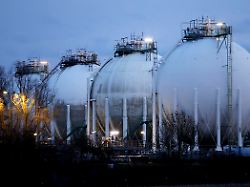Equipped for extreme cold
German gas storage facilities filled “far above average”.
December 29, 2023, 2:35 p.m
Listen to article
This audio version was artificially generated. More info | Send feedback
Winter has long since begun and the German gas storage facilities are still full to the brim. The industry association and the Federal Network Agency see this as good news. Germany would therefore be prepared even for extremely low temperatures. But fewer and fewer people want to save energy.
Germany is entering the new year with abundant natural gas storage facilities. The overall level was 90.8 percent in the morning, according to the Data from the European Gas Storage Association GIE emerges. Exactly a year earlier it was 88.8 percent. The largest German storage facility in Rehden, Lower Saxony, was 81.2 percent full in the morning. The storage facilities are still quite full across the EU. According to GIE, the fill level was 87.0 percent.
The amount of gas in full storage corresponds roughly to the consumption of two to three average cold winter months. The gas storage facilities in Germany were last 100 percent full on November 5th.
The gas storage facilities compensate for fluctuations in gas consumption and thus form a buffer system for the gas market. The levels usually decrease in winter and increase again after the end of the heating season. In the past few weeks, unlike usual, there have been several days on which more was deposited than withdrawn, meaning the filling levels increased.
Stable imports from Norway and the EU
According to the Ines storage association, the current filling level is “well above average”. “The mild temperatures in November and December ensured relatively low consumption and avoided a greater emptying of the gas storage facilities,” said Sebastian Heinermann, managing director of the industry association Initiative Energiespeicher (Ines).
The President of the Federal Network Agency, Klaus Müller, expressed his satisfaction: “People have saved a lot of gas this year. This has given us a good cushion for the winter. The storage facilities are still very well filled. We are good for the second half of winter “A few cold days are not a concern. But at the beginning of December we could see how much gas consumption increases as soon as it gets colder,” he explained. Stable imports are therefore important to secure gas supplies.
Still Gas flows permanently to Germany and into storage, primarily through pipeline imports. According to the Federal Network Agency, on Wednesday most of the gas came from Norway, the Netherlands and Belgium. Gas also flowed into the German gas network via the new LNG terminals on the German coasts. Germany also purchased natural gas from Switzerland and Denmark.
Equipped for extreme cold
The industry association is also confident that gas supplies will be secured this winter. “The gas supply should now be fully guaranteed even at extremely cold temperatures,” said Ines managing director Heinermann. “If no unforeseen risks arise, we will get through the rest of the winter well.”
Netzagentur boss Müller said he was grateful that many people were using gas more consciously. It is worth thinking carefully about how much consumption can be saved. “Every kilowatt hour saved also protects the household budget,” he emphasized.
However, saving energy as a New Year’s resolution is much less popular in households this year than in 2022. This emerges from surveys carried out by the opinion research institute Yougov for the energy service provider Ista. While around a year ago, during the energy crisis, around 43 percent of Germans resolved to use less energy in their households, in 2023 the figure will be only 29 percent.
